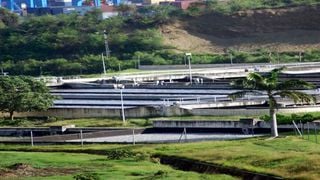
The Kipevu Sewerage Treatment Plant at Kipevu in Changamwe District which serves Mombasa's west mainland only.
| File | Nation Media GroupMombasa
Premium
Alarm as Mombasa spews raw waste into Indian Ocean
What you need to know:
- Kizingo Sewerage Treatment Plant, which was constructed two decades ago with a design capacity of 10,000m3 per day, is out of service.
- In his 2020 State of the County Address, Governor Hassan Joho acknowledged sanitation coverage in the devolved unit was wanting.
As big waves and high tides sweep across the Indian Ocean, huge piles of garbage are daily washed ashore at the Kenyan Coast.
In the Old Town area, sewage pipes discharge wastewater directly into the ocean, causing health risks to both human and marine life.
The county lacks a sewage treatment system, hence ‘diverting’ its waste to the sea after its two plants, built more than 20 years ago, broke down.
Kizingo Sewerage Treatment Plant, which was constructed two decades ago with a design capacity of 10,000m3 per day, is out of service.
Kipevu Sewerage Treatment Plant has a capacity of 17,100m3 per day but it handles about 6,000 and 7,000m3 per day. It serves Mombasa West residents, including Changamwe, Port Reitz, Magongo and Jomvu.
On January 10, Mombasa Land, Planning and Housing Executive Tawfiq Balala issued a notice to all developers, consulting architects and engineers for building development (new, ongoing and existing) within Majengo and Old Town areas to halt their projects for public health and safety audits.
“The audit seeks to take corrective actions against the illegal raw sewerage connection to storm water drainage in the areas. Approval for development applications within the named areas of Mvita sub county is suspended forthwith and all ongoing development stopped until compliance with the condition of approval of installation of bio-digester is satisfactorily implemented,” stated the order.
Mombasa residents, led by Mr Rishi Parikh, took to social media to call for urgent intervention.
Mr Parikh said the only feasible solution is for the county to force property owners to install septic treatment tanks.
Sewerage connections
“They avoided doing this to reduce construction costs. Most new buildings simply join their exit sewer pipes to storm drains onward to the sea, where the ecosystem is being destroyed. Enforce this. By the time Mombasa gets a proper sewage system and treatment plant it will be a decade,” he said.
In his 2020 State of the County Address, Governor Hassan Joho acknowledged sanitation coverage in the devolved unit was wanting.
“We have taken steps to address these challenges comprehensively. I have directed the Department of Water to take measures to ensure the challenges are fixed, including the redevelopment of the physical infrastructure network and a clear sanitation management system,” he said.
Two years later, the situation only got worse. A certified environmental inspector, Mr Benson Wemali, said the ocean is contaminated due to the raw sewerage.
“Households lack sewerage connections. Most houses in the city have soak pits and septic tanks,” he said.
The Coastal Oceans Research and Development – Indian Ocean (Cordio) East Africa director, Mr David Obura, urged the county to rehabilitate or revegetate the affected areas.
“Toilet and sewage contains bacteria and other microbes that can cause diseases and imbalance in marine systems, especially for people who come in contact with the water, or species that live in the sea by eating infected fish,” he observed.
He blamed the county government for polluting the sea.
Dwindling of fish stocks
“They are discharging raw sewage, industrial waste and domestic trash into the sea. The creeks around Mombasa have been polluted with the water appearing brown or green, instead of blue,” said Dr Obura.
“They will lose their health and productivity and affect tourism. It will also cause dwindling of fish stocks. Mombasa might lose most of the benefits it gets from the sea in terms of food and tourism attractions,” he added.
According to Cordio, other areas affected by sea pollution include Kilifi, Malindi, Watamu, Shimoni and Lamu.
“Our entire marine system is being polluted by the growing population and development on the land, and the effects are spreading and becoming more evident at the sea. We are turning our sea into a dumpsite, especially around the Tudor creek,” decried Dr Obura.
Mr Wemali said anyone who plans to build a house must ensure they have a bio-digester, which costs around Sh1 million, or a treatment plant, depending on the flow of gravity.
“Hotels and companies have septic tanks and few have treatment plants. Honey suckers are also spilling their sewage into the ocean,” he observed.
A team of volunteers at the beach has been collecting syringes from the mouth of Mtopanga River.
“They are mostly from clinics and pharmacies in Bamburi and Mtopanga. You can imagine how many are in the sea and on the beachfront, where we run barefooted,” said Mr Silas Juma, a Mombasa environmentalist, who has been leading beach clean-up exercises.
Collapsed sewer systems
Only 17 per cent of the county is connected to the Kipevu Sewerage plant.
National Environment Management Authority (Nema) county director Samuel Lopokoiyit said Mombasa sewer systems have totally collapsed.
“The Kipevu one was refurbished by President Mwai Kibaki 10 years ago but it has collapsed. In 2020, Nema ordered Mombasa Water Supply and Sanitation Company Limited (Mowasco) to repair the pump stations and treatment plants. The order was not adhered to,” he said.
Mr Lopokoiyit said in March last year they inspected all the discharge points, especially in Old Town. This led to the arrest and prosecution of former Mowasco managing director Anthony Njaramba. The case is ongoing in court.
Mr Lopokoiyit said Mowasco then moved fast to start repairing the sewer lines. They later conducted an Environmental Impact Assessment and currently, there’s an engineer repairing the plants.
The county was given until March to stop dumping waste into the ocean.
“We know that there’s pollution but they are repairing the pump stations. We are aware untreated sewage is dumped into the ocean that’s why we have moved in to find a lasting solution. But works are in progress and we know that by March it will be a thing of the past,” he added.
Mowasco managing director Abdirahim Farah noted: “The main sewer lines are collapsing one after another immediately after we repair them. But with the World Bank, who are injecting Sh3 billion on five projects, the sewer lines are being overhauled. We are grappling with illegal connection from houses to the storm water that is discharged to the ocean.”





